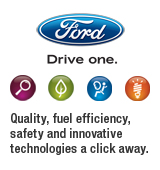Renewed Commitment
To channel this development effort and help ensure Ford's leadership worldwide, we created a dedicated vehicle dynamics organization, the Global Vehicle Dynamics (GVeD) Department, located in Germany and Belgium. GVeD develops segment-tailored, vehicle-specific ride and handling features and technologies including improved steering performance, braking systems and automotive suspensions.
While the team is making significant progress in continuous improvement of suspension concepts, it is also working on other technologies, including Continuously Controlled Damping, Ford Active Steering, Steering System Test Machine and Interactive Vehicle Dynamics Control.
Have More Fun on the Road
All our vehicles are designed to be safe and comfortable. To make them stand out and appeal to the driving enthusiast, we designed distinctive vehicle dynamics features to allow the car to perform optimally under a variety of road surface and weather conditions.
Everyday Challenges
Besides the need to make vehicles more exciting to drive, our vehicle dynamics engineers must also respond to the changing demands on modern vehicle suspensions. For instance, as consumers demand higher fuel efficiency, our engineers are developing ways to make suspensions lighter. To respond to these challenges, our engineers develop innovative concepts using new materials and design to achieve improved driving, steering and braking performance.
Dynamics Improvements on the Road
Our engineers don't just think up great ideas; they also design real-world applications to make vehicles more exciting to drive. The following technologies are already on the road:
- RevoKnuckle&EEMM;Due to increasing engine output,steering performance disturbance is becoming more noticeable to the driver of a front-wheel-drive passenger vehicle. The RevoKnuckle minimizes steering performance disturbance and is compatible with the standard automotive suspension system for vehicle derivatives with low- to medium-power output engines.
- 2006 Ford Focus World Rally Car&EEMM;GVeD engineers enhanced the new Ford World Rally Car suspension and assisted in the development of the rear-axle trailing arm. After a short 11-month development time, the car won several World Rally races in 2006 and completed its successful first year in competition by winning the FIA WRC Manufacturers' Championship.
- Continuously Controlled Damping (CCD) &EEMM; CCD controls a vehicle's pitch and roll by monitoring and adjusting the damper rate every two tenths of a second based on variations in vehicle speed, road surface characteristics and other factors.
The CCD feature debuted on Ford's all-new 2006 S-MAX and Galaxy as an option. Customers can choose their ride preference from one of the three settings: Sport, Normal or Comfort.
- Interactive Vehicle Dynamics Control (IVDC) &EEMM; IVDC demonstrates how effective system integration (especially vehicle dynamics systems) improves performance in next-generation vehicles.
One example of system integration is the use of CCD and ESC systems currently available on the 2006 Ford S-MAX and Galaxy models: while the ESC system attempts to stabilize the vehicle in case of loss of stability with actions on the engine and brakes, the CCD system improves suspension performance and allows the driver to select a different suspension setting. The interaction between these two systems improves the vehicle dynamic behavior and reduces the stopping distance on rough road surfaces when ABS braking is applied.
Electronics and software will play big roles in future vehicle performance. The IVDC strategy was developed to meet the challenge of future vehicle dynamics demands, and software is the solution to realize the IVDC concept.



